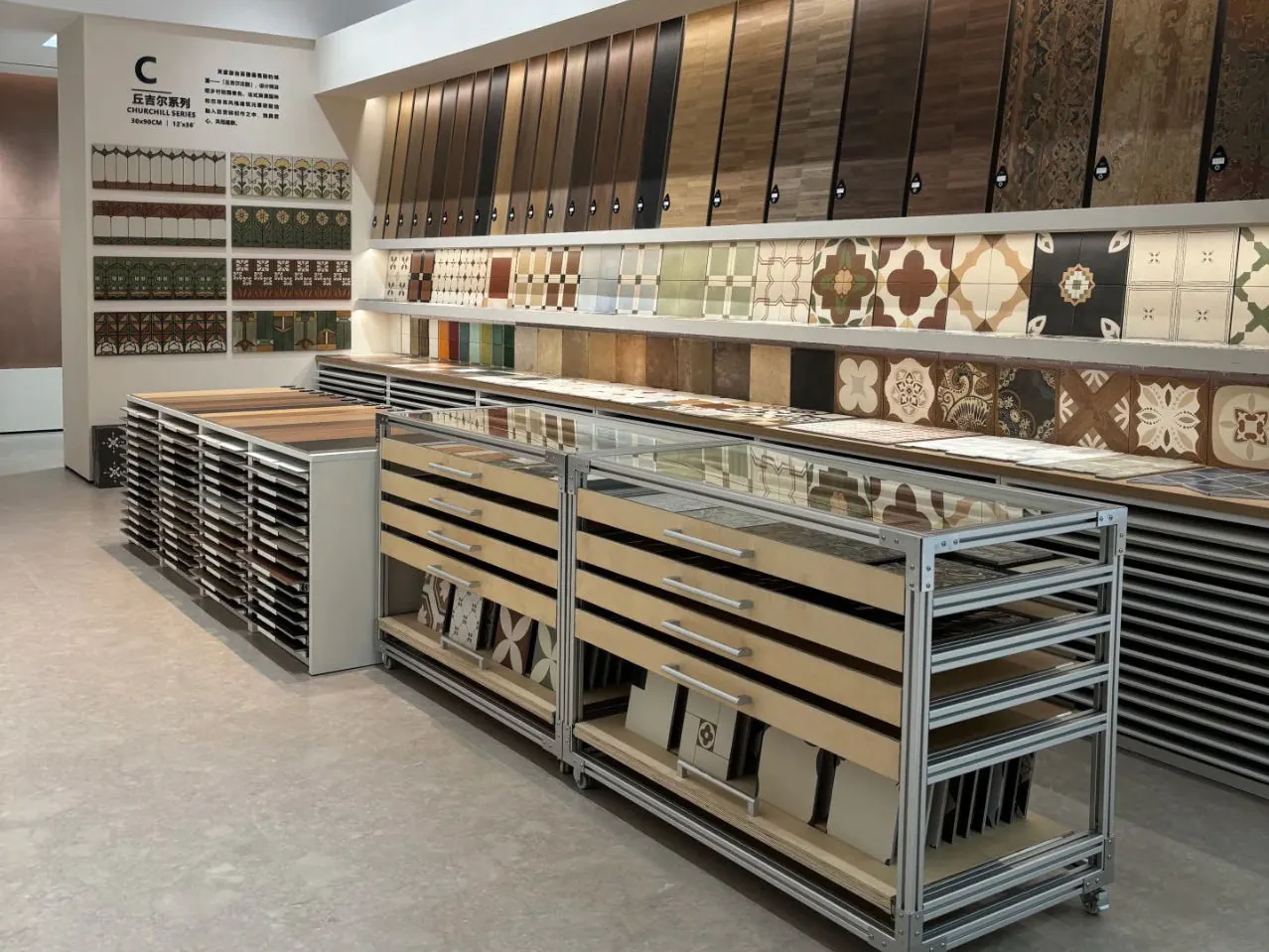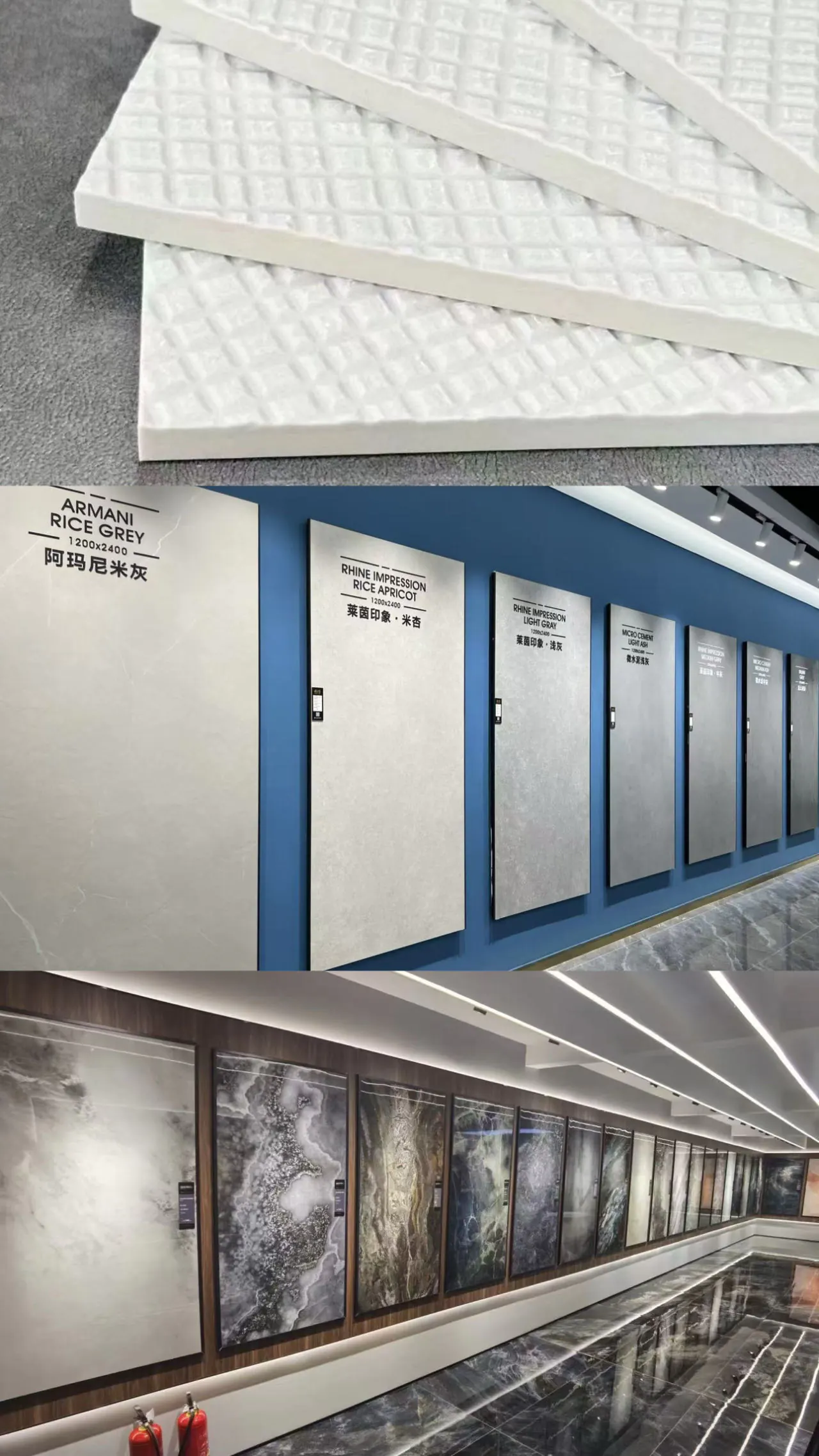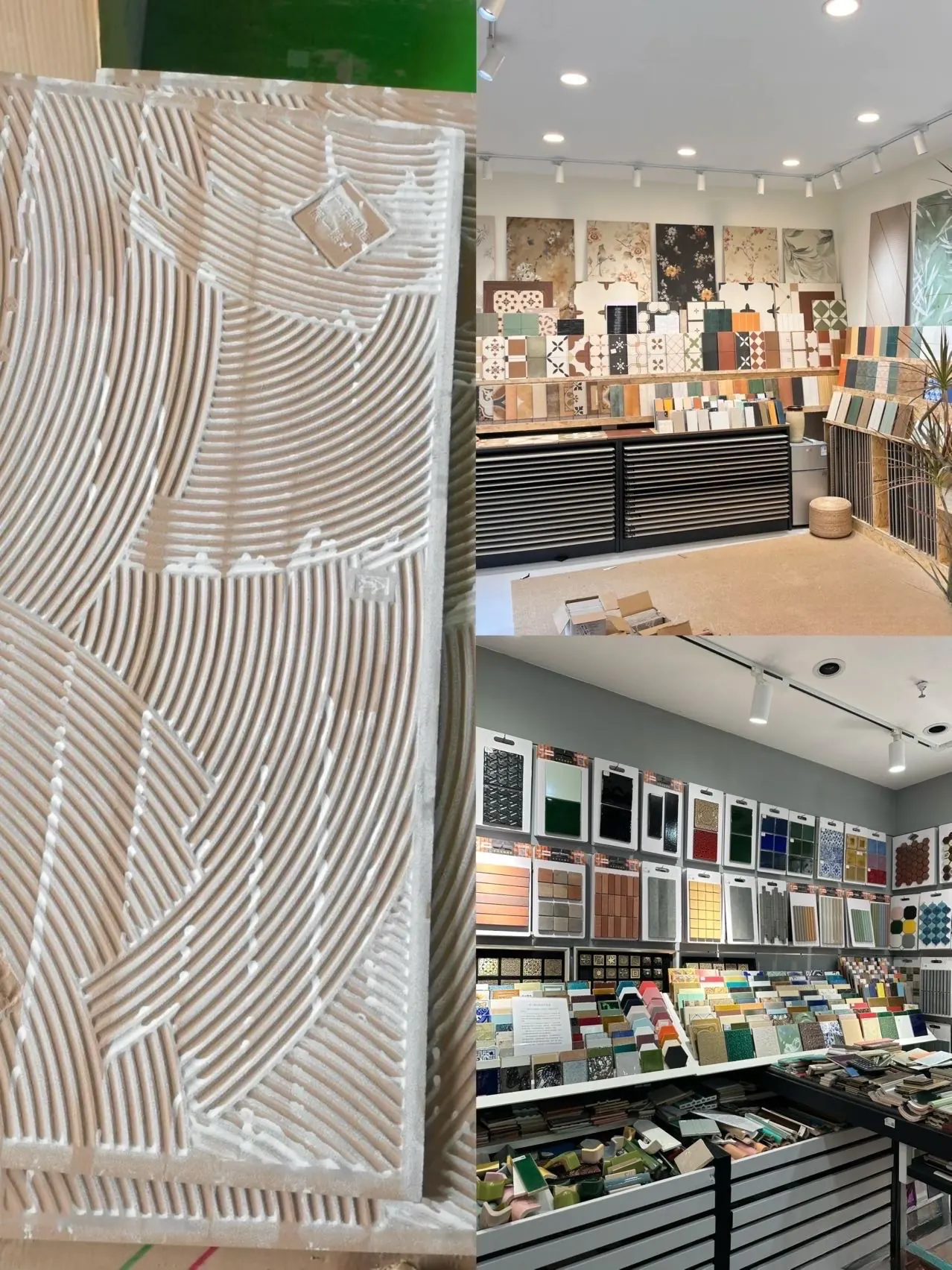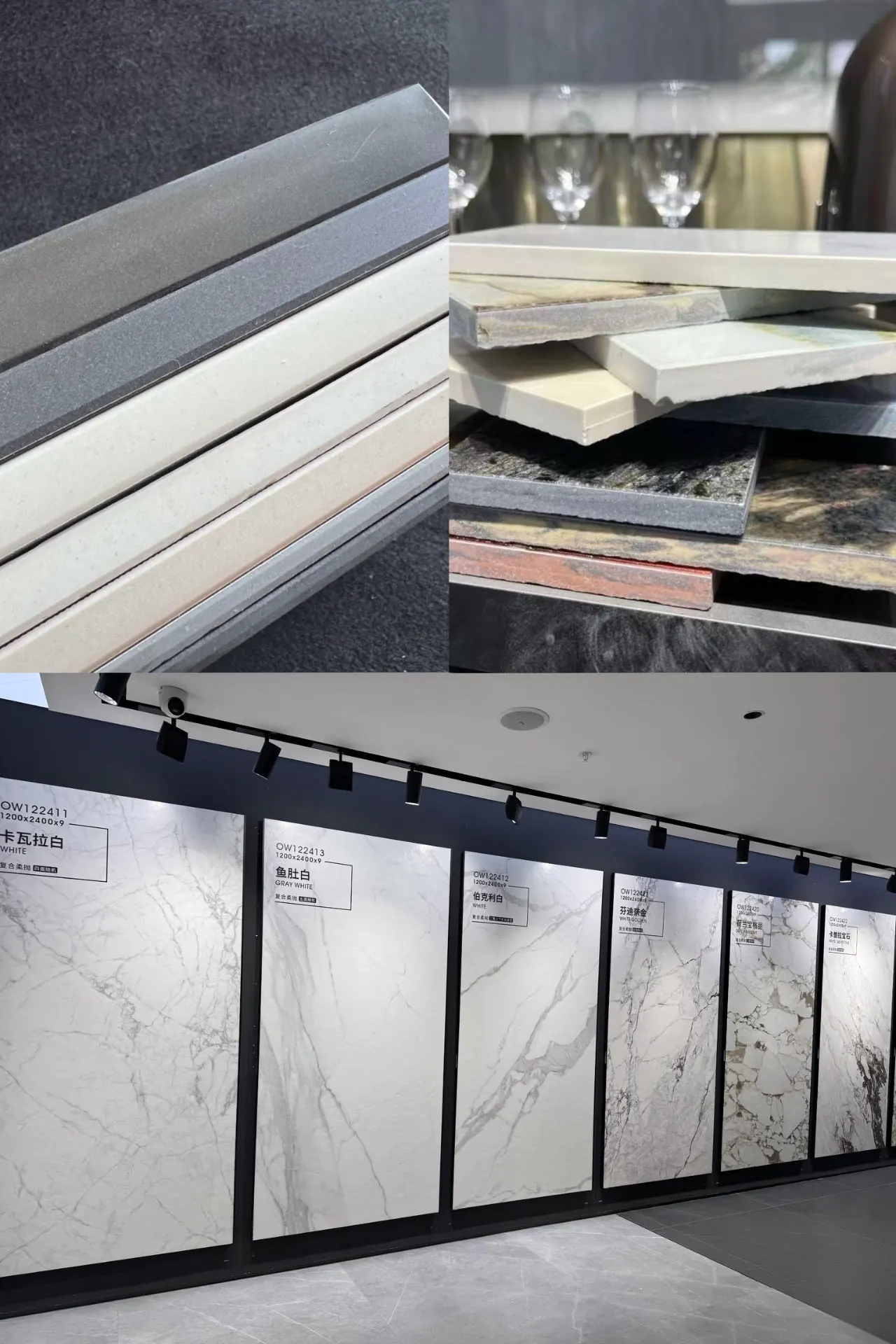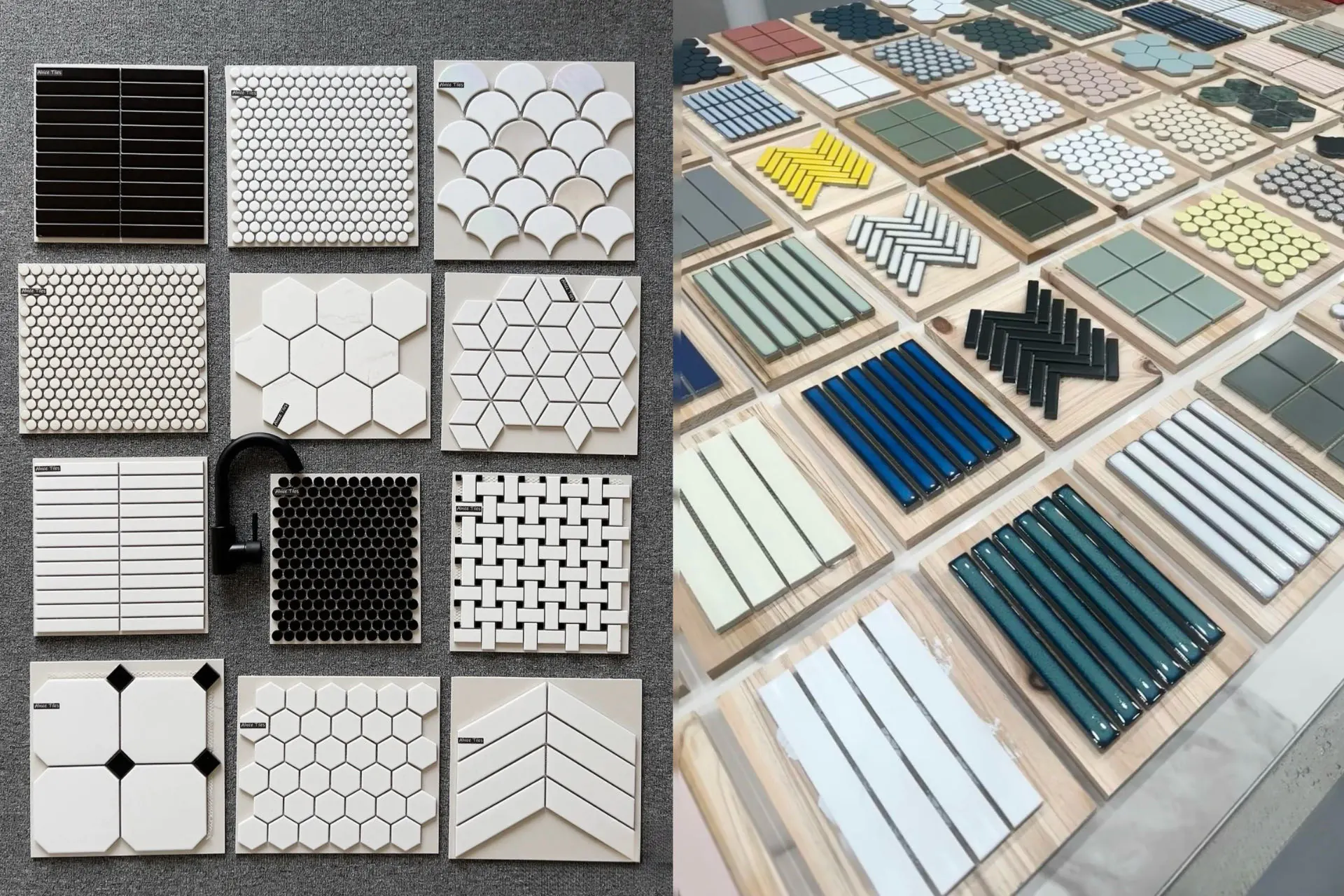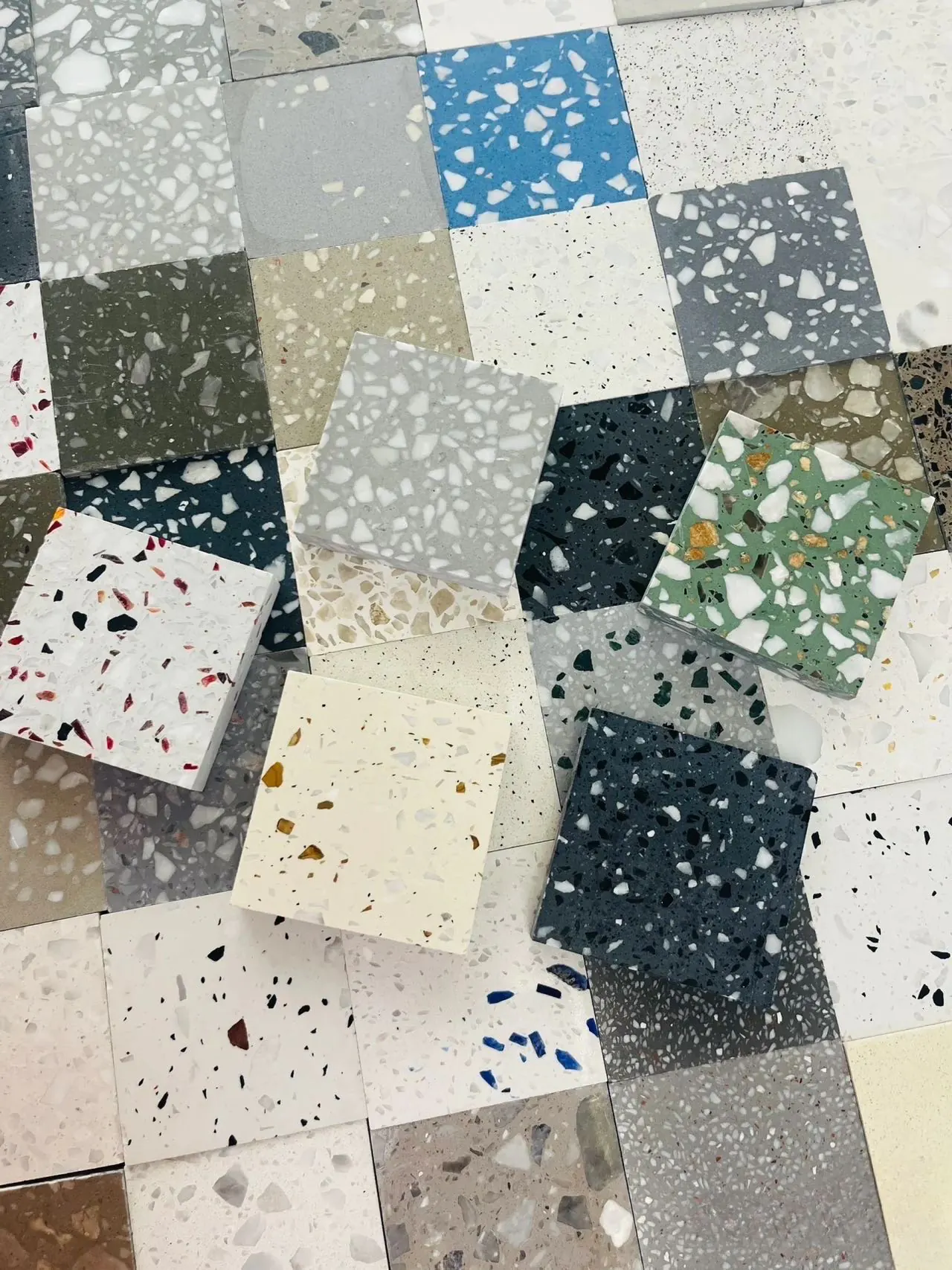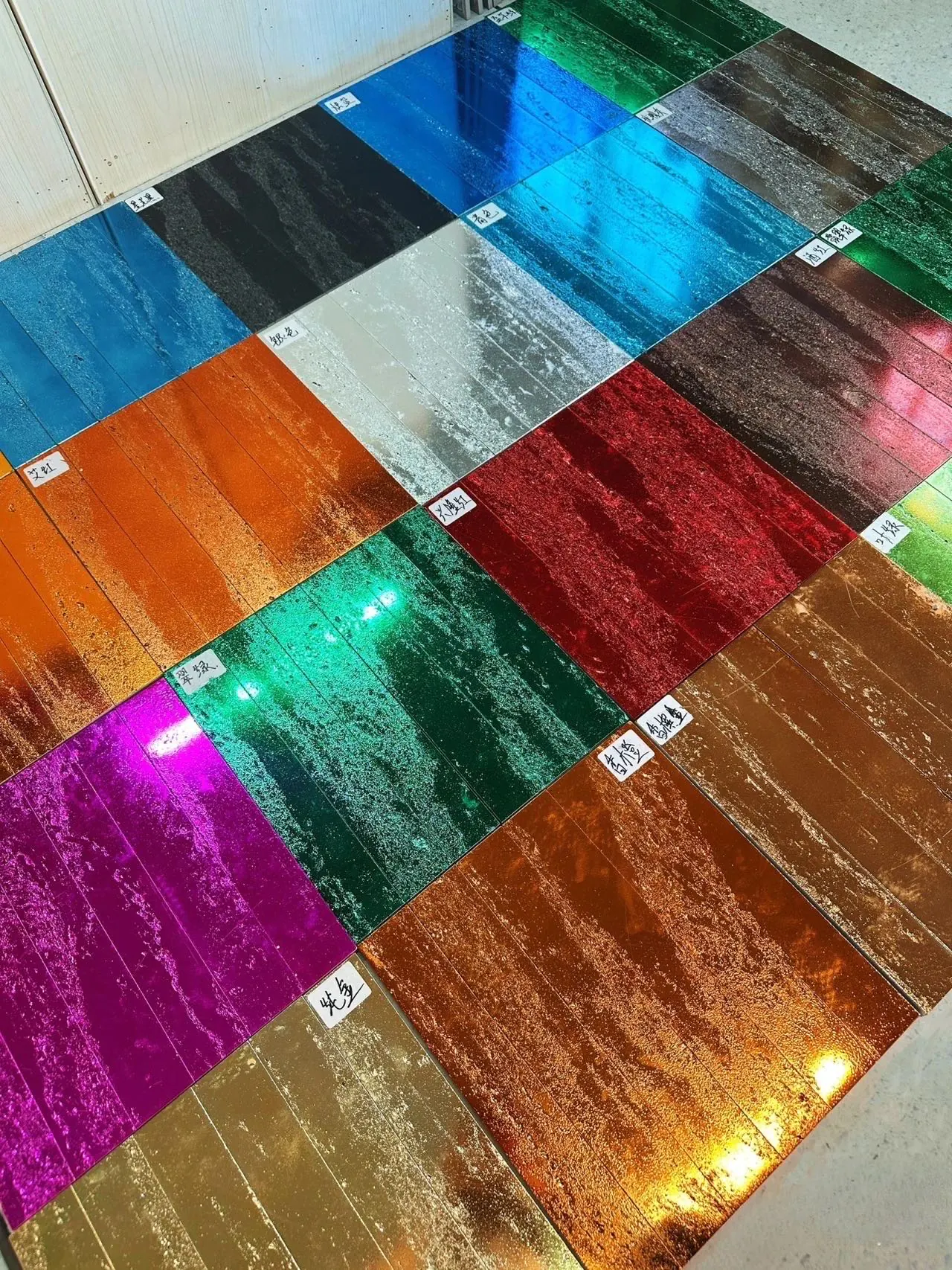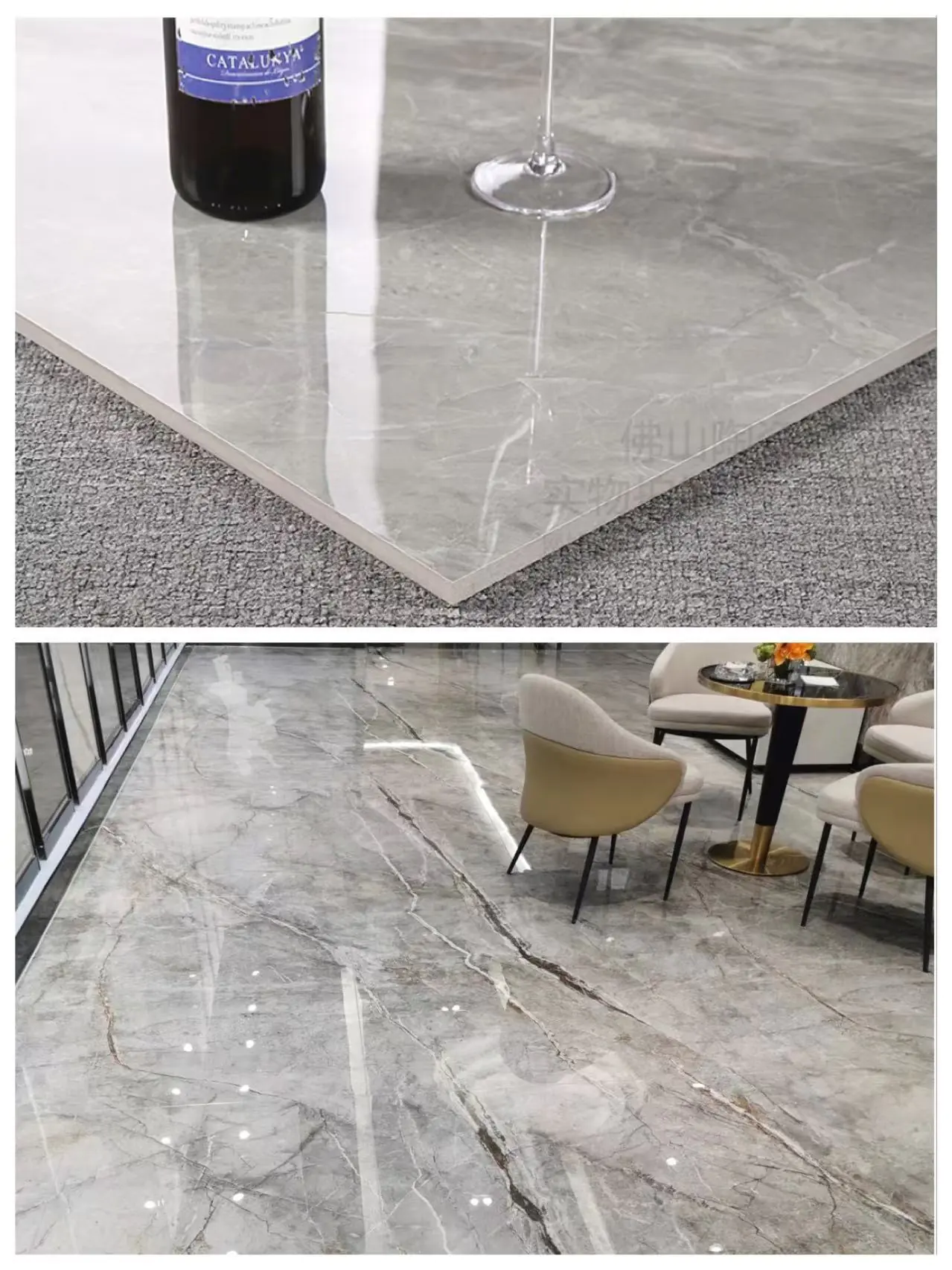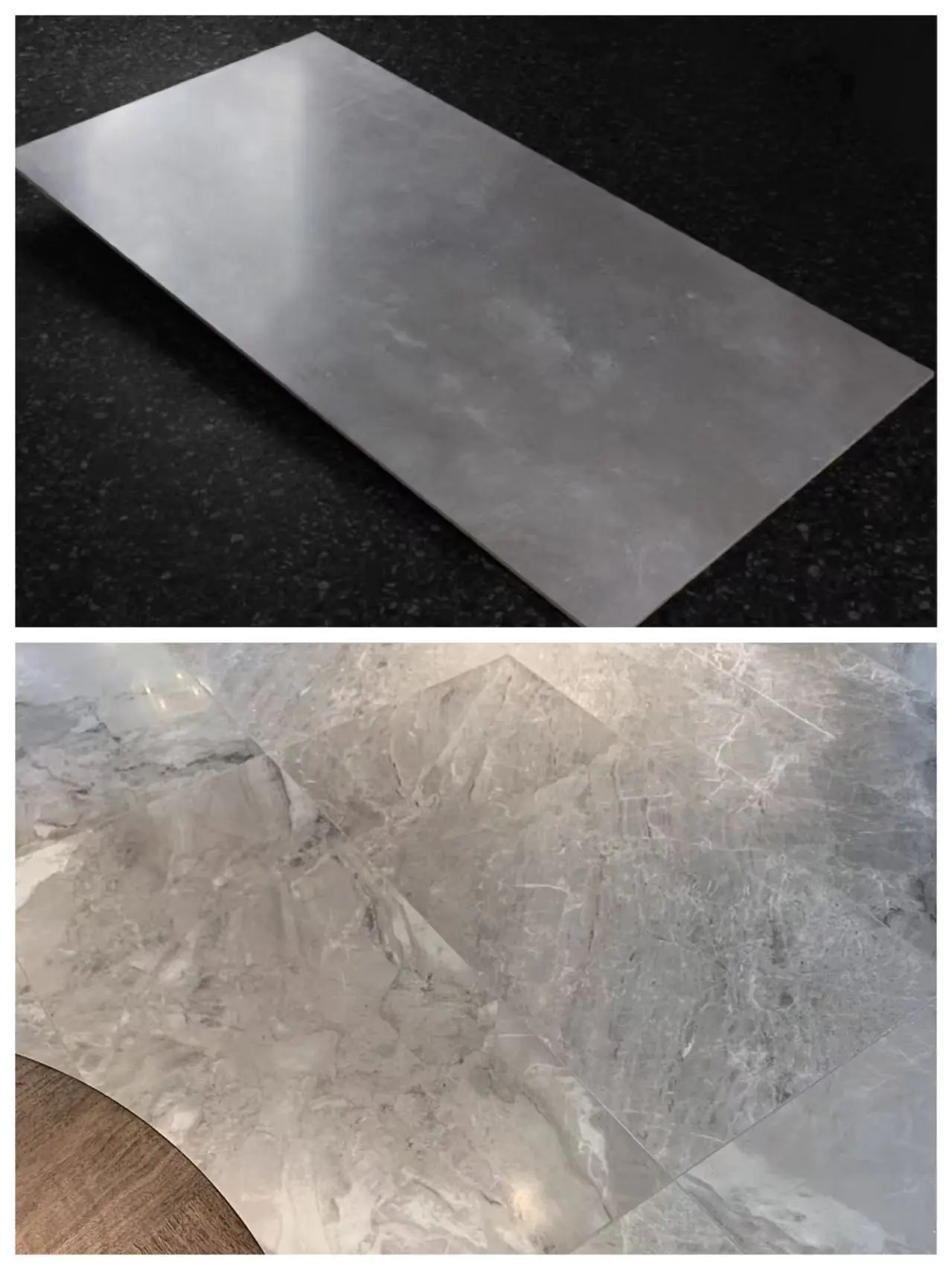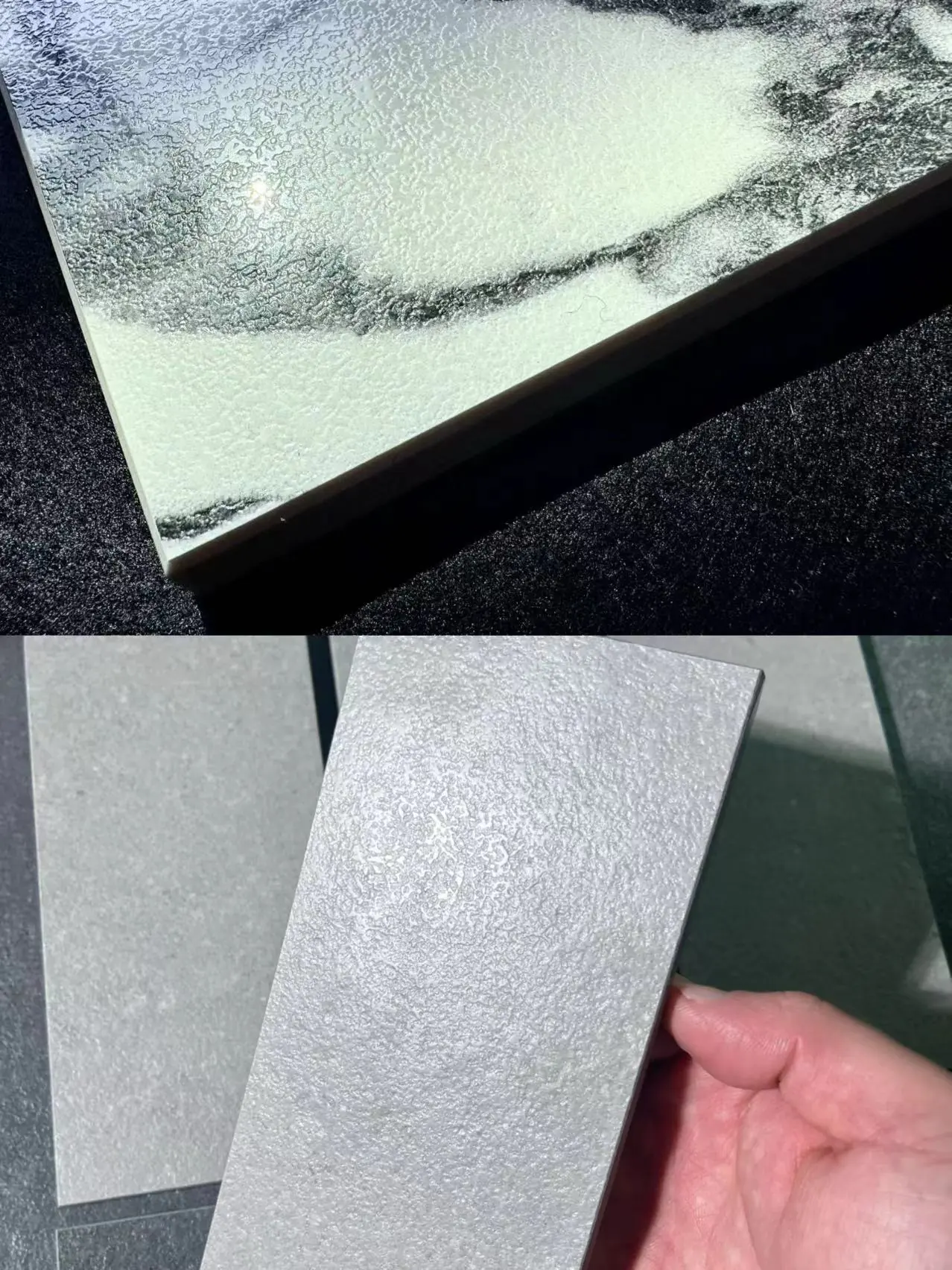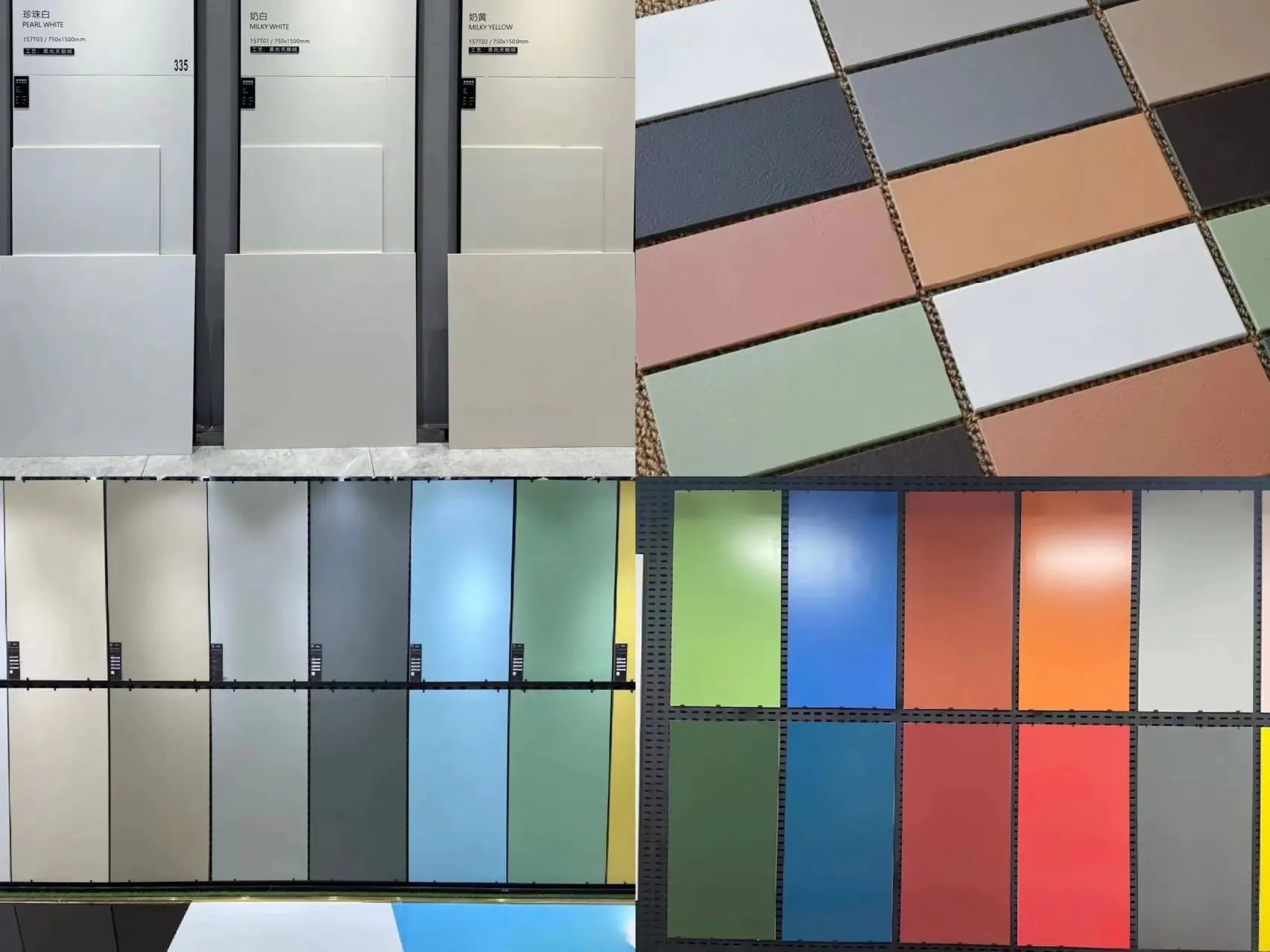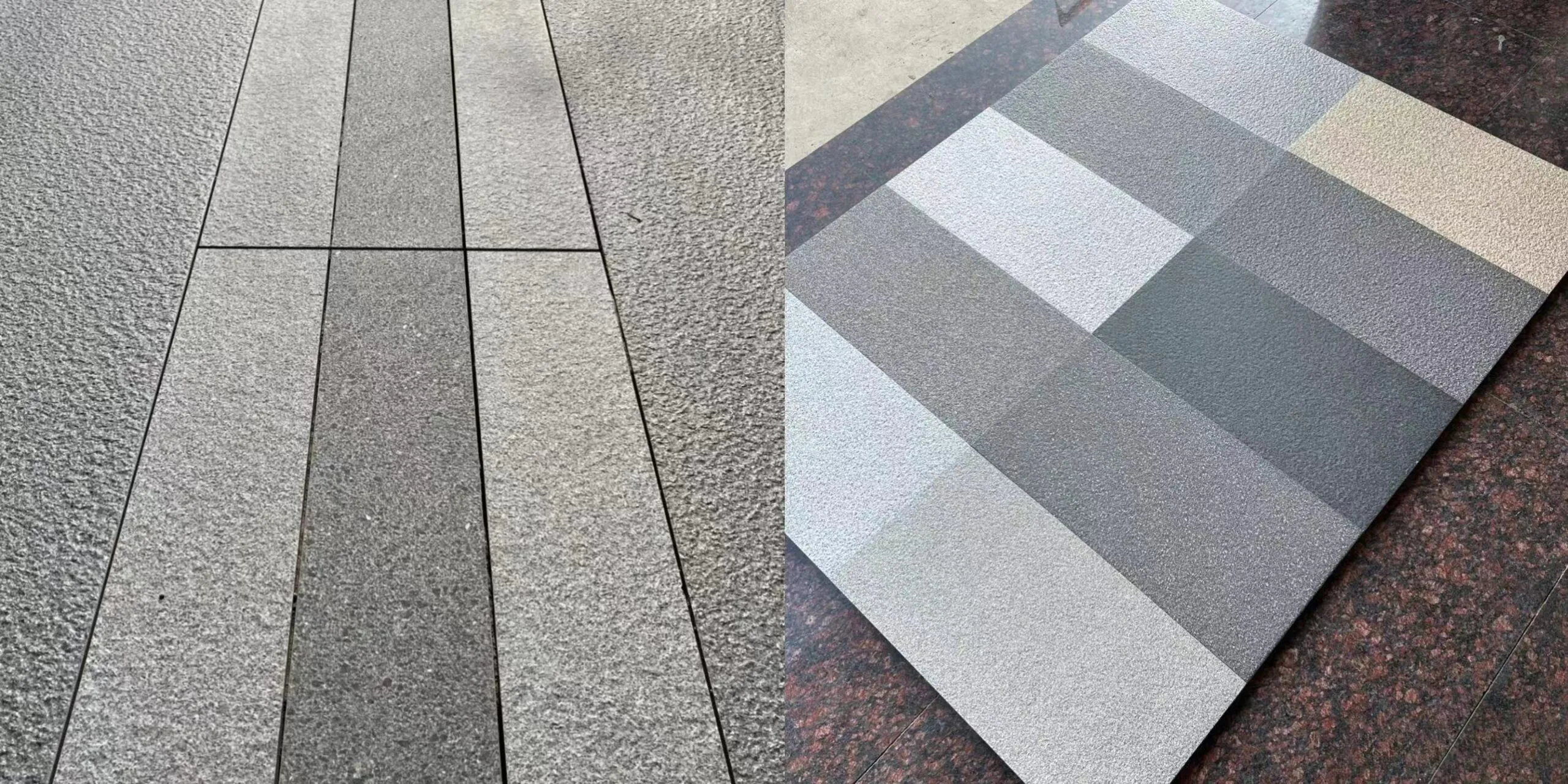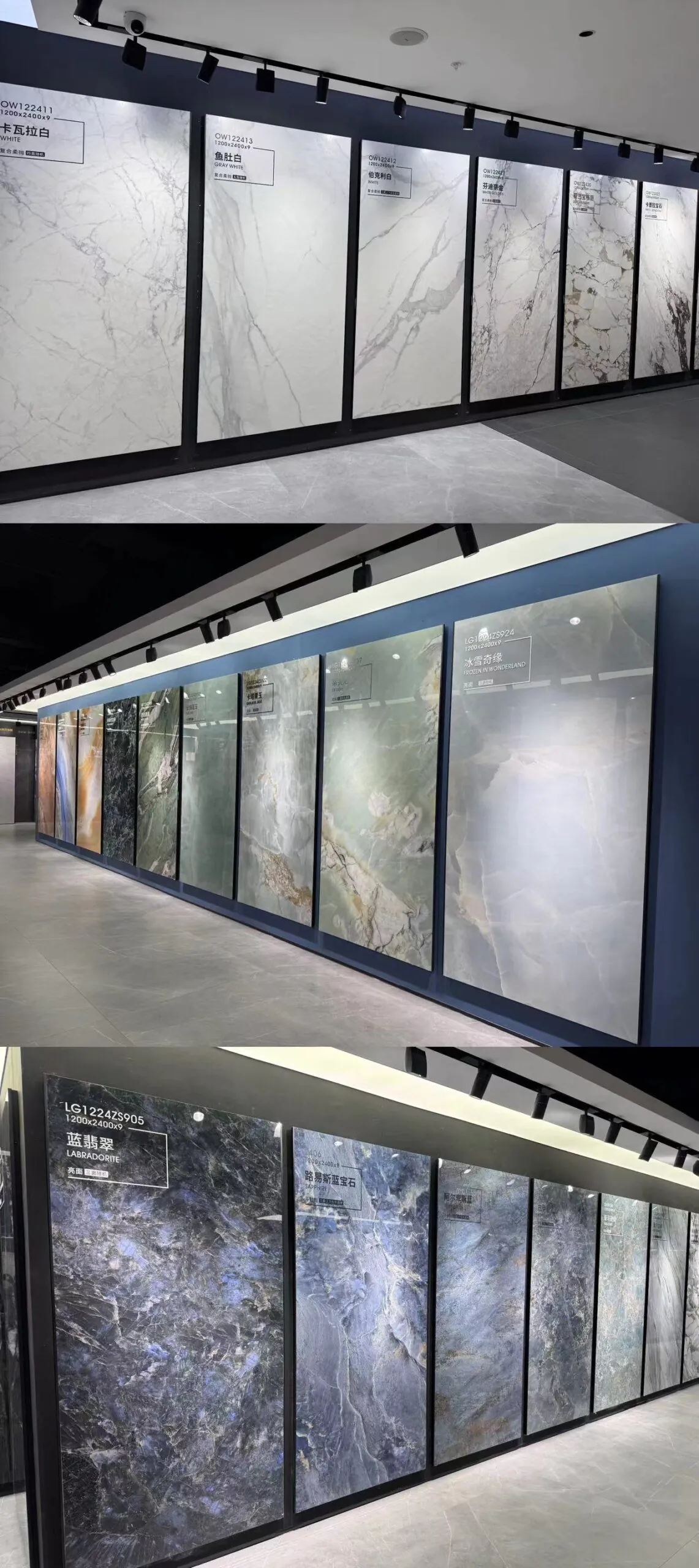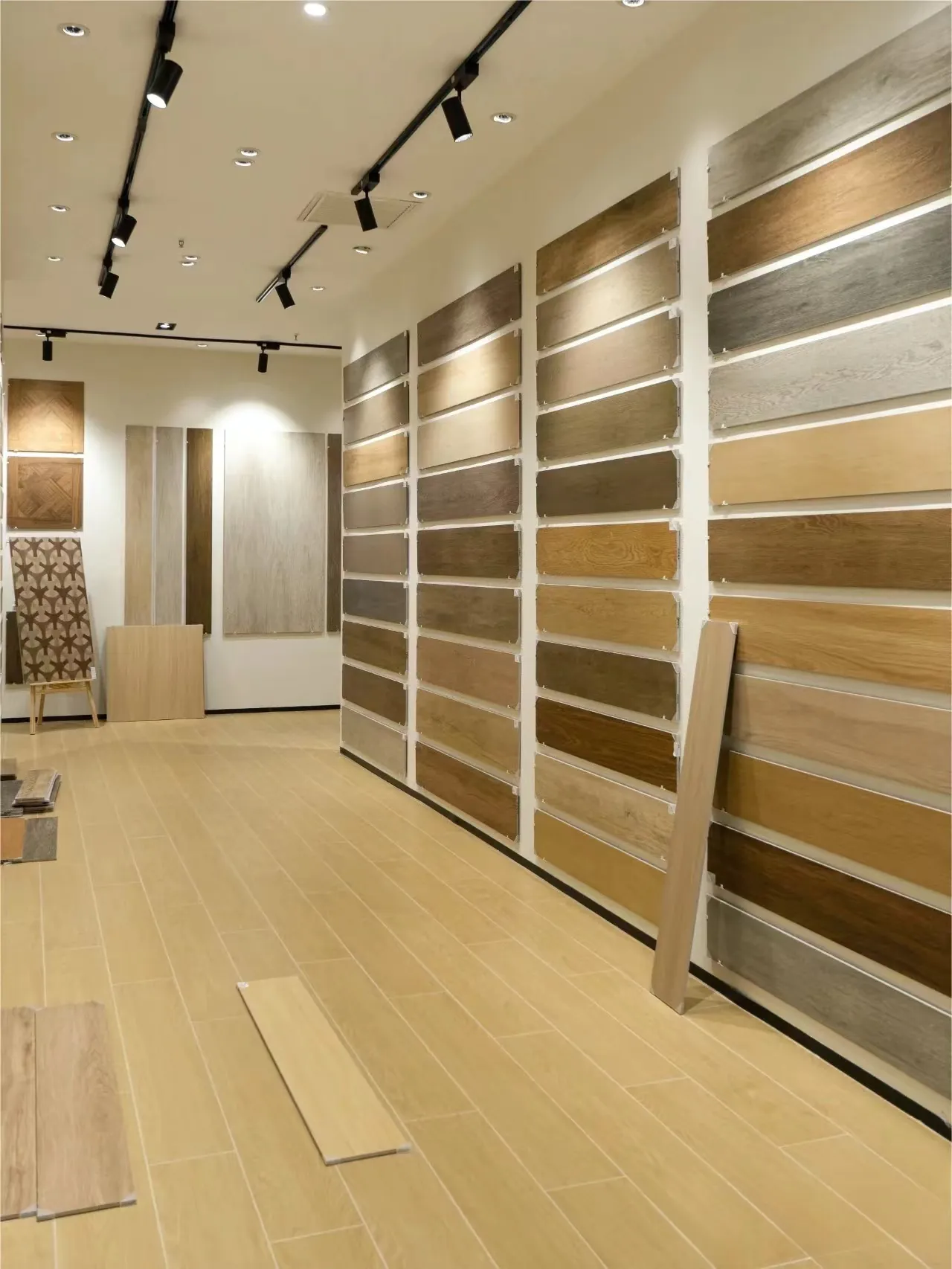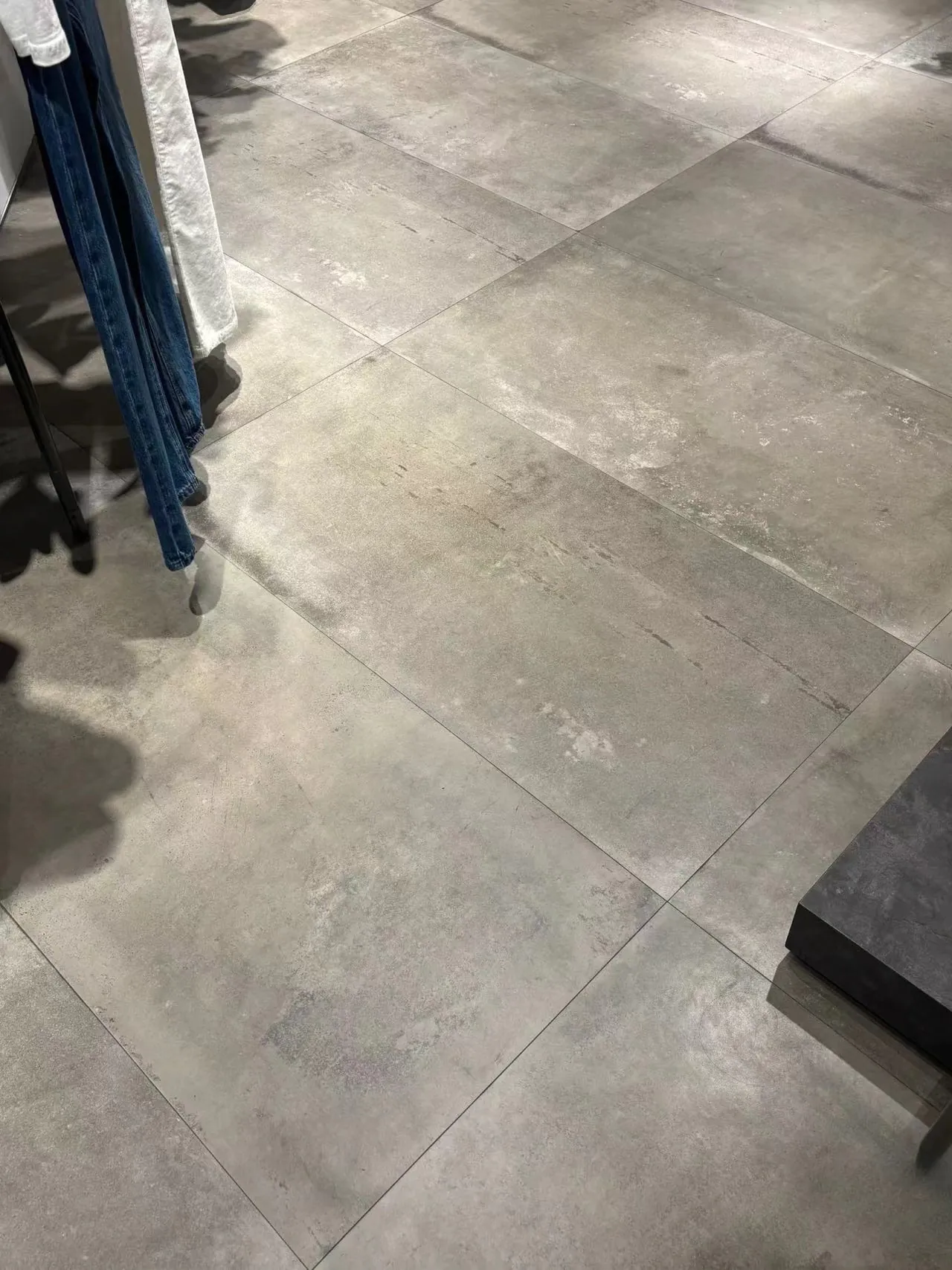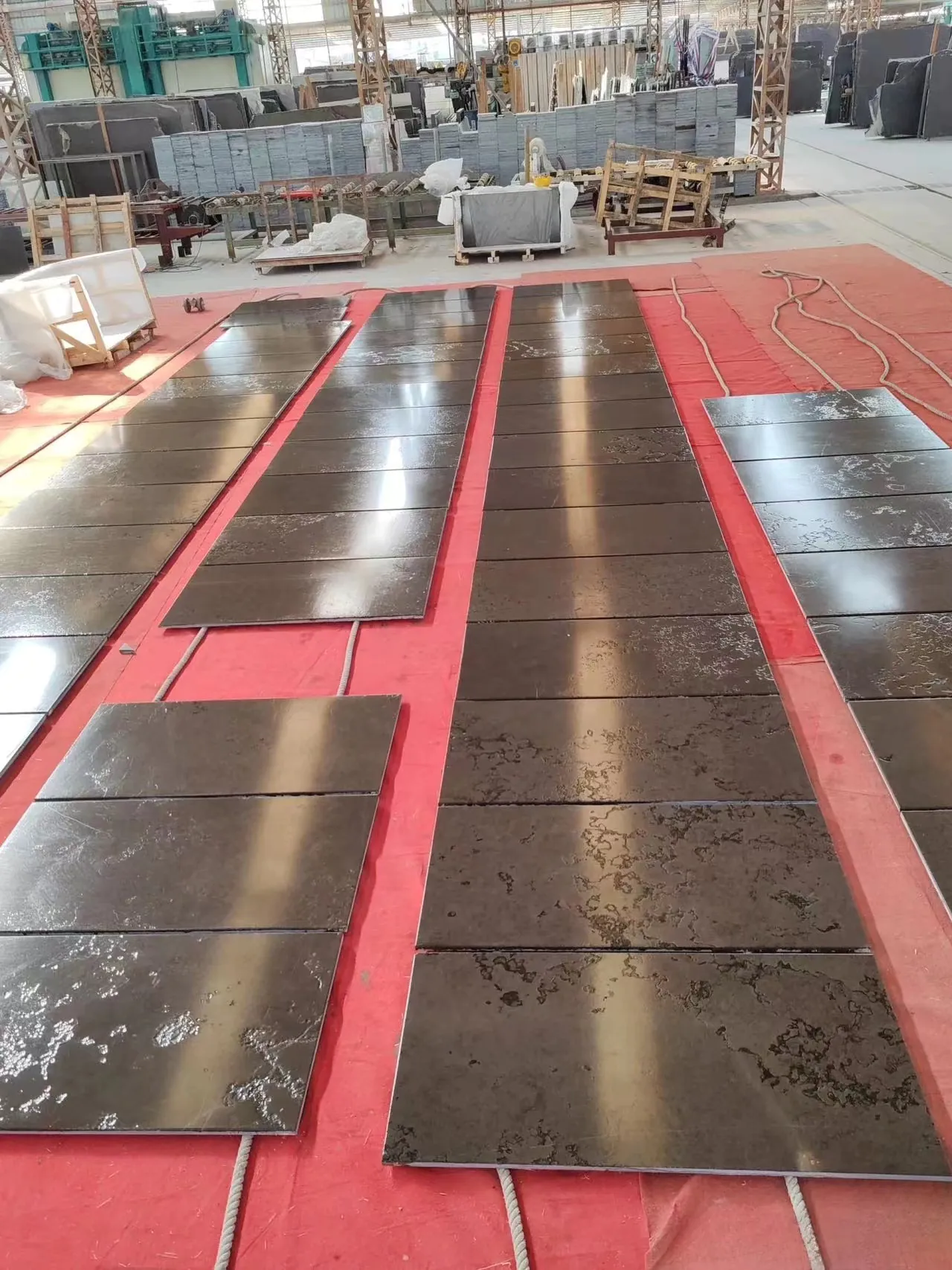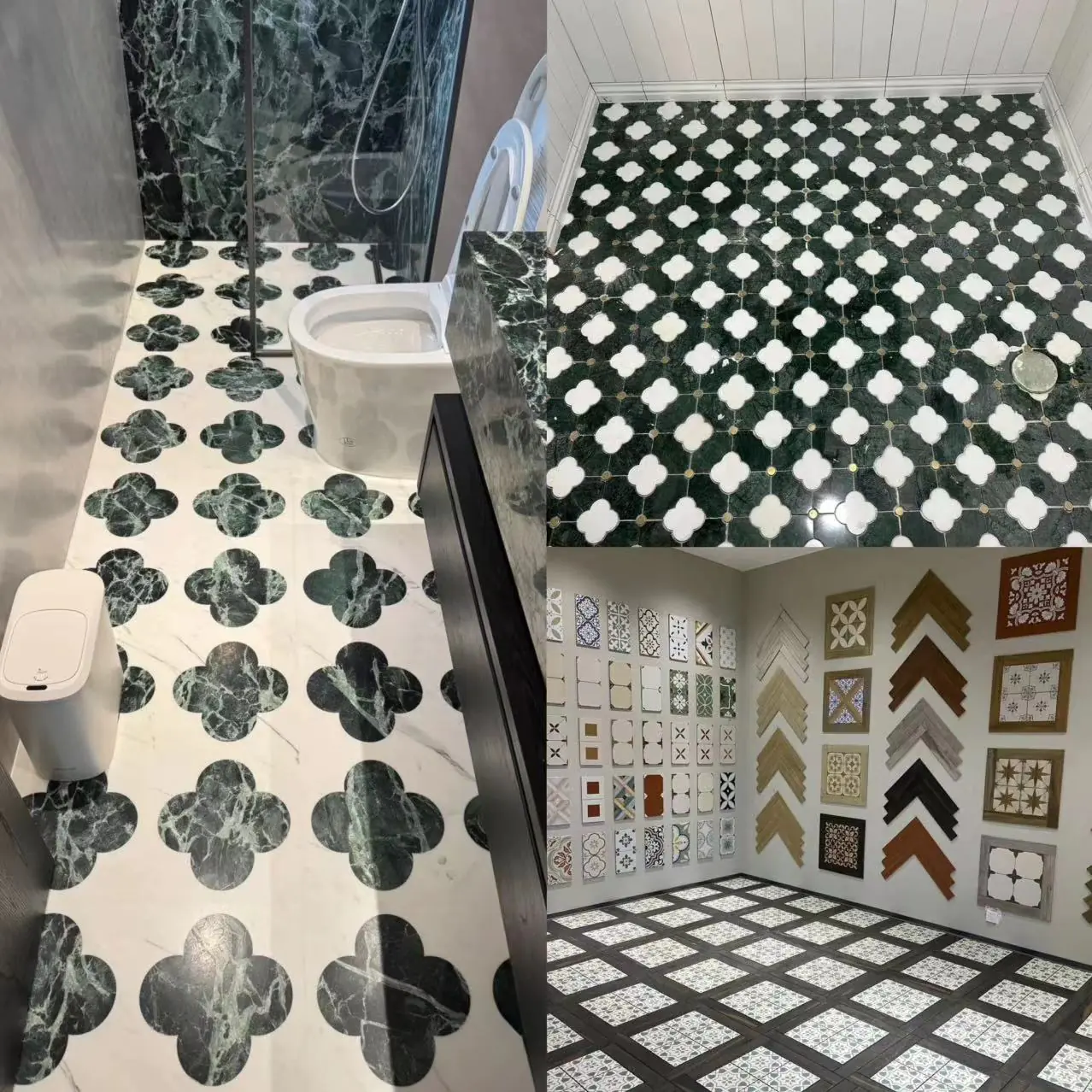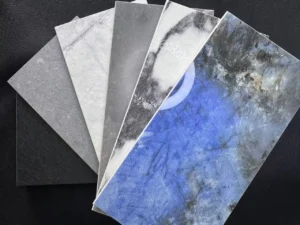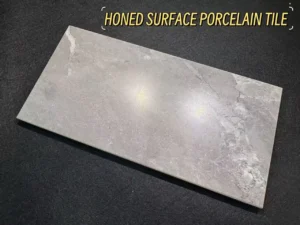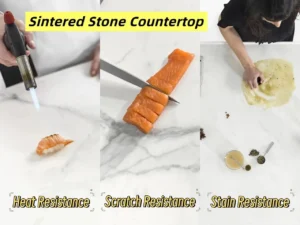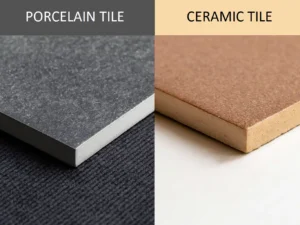Floor tiles come in a vast range of materials, surface finishes, and design patterns. Each category influences the tile’s performance and appearance. Understanding these types will help in choosing the right tile for any project. For example, a factory like Kingsun (China) produces many kinds of porcelain, ceramic, and even sintered stone tiles to meet diverse design needs. Below, we break down tile options by material, finish, and pattern.
By Material Type
Tiles can be categorized by the material they are made from. Material affects a tile’s durability, water absorption, and where it’s best used. Here are the core material types and their characteristics:
Porcelain Tile
Porcelain tile1 is a type of ceramic tile made from dense, refined clay fired at higher temperatures. This process yields a tile that is harder and less porous than standard ceramic. In fact, porcelain’s defining feature is its very low water absorption (≤ 0.5%). This minimal porosity means porcelain works well in wet areas and even outdoors, as it resists water and frost damage. Porcelain tiles are also extremely durable and wear-resistant, making them suitable for high-traffic floors. They can be glazed with surface colors or left unglazed (full-bodied). Thanks to their strength and low moisture uptake, porcelain is often the go-to for commercial flooring, outdoor patios, and bathrooms.
Ceramic Tile
Ceramic tiles are the broader category that includes porcelain, but in everyday terms “ceramic tile” often refers to the standard, non-porcelain tiles made from less dense clay. These tiles are usually glazed with colors or patterns on the surface. Ceramic tiles are durable for most indoor uses but are more porous and slightly less hard than porcelain. Because of their higher water absorption (typically 3–7%), regular ceramic tiles are generally recommended for indoor use only. They’re ideal for kitchen backsplashes, bathroom walls, and low-to-moderate traffic floors. Ceramic tiles tend to be a bit easier to cut and often more budget-friendly than porcelain. However, they may not hold up as well in outdoor or high-traffic situations, as they can wear or absorb moisture over time.
Sintered Stone Tile
Sintered stones2 is a newer engineered material that’s gaining popularity for flooring and surfacing. It is made by fusing natural minerals (like those in porcelain and stone) under extremely high pressure and heat. The result is an ultra-dense, non-porous slab that looks like natural stone but has enhanced performance. Sintered stone tiles (sometimes sold in large slab formats) are incredibly durable – they resist scratches, stains, and can withstand hot, cold, wet, or dry environments. In other words, this material is one of the toughest surface options available, suitable for both indoor and outdoor use. Sintered stone doesn’t require sealing (due to its non-porosity) and won’t fade or discolor easily. It often mimics the appearance of marble or other stones, providing a luxury look with very low maintenance. While sintered stone is similar to porcelain in how it’s made, it’s typically thicker and even stronger, which is why it’s used for large-format floor tiles, countertops, and building facades.
Mosaic Tile
Mosaic tiles are small-format tiles (usually 2 inches or smaller, often 1 inch or less) that are typically mounted in sheets. A mosaic design consists of many tiny pieces of tile – these pieces can be ceramic, porcelain, glass, stone, metal or other materials – arranged in patterns or images. The small tiles are usually pre-attached to a mesh backing, which makes installation easier by handling them as a unit. Mosaics are very versatile: you’ll find them in shower floors (the numerous grout lines add slip resistance), kitchen backsplashes, and as decorative accents on floors or walls. They can create intricate patterns or pictures that larger tiles can’t. Despite their smaller size, mosaic tiles are generally durable (it depends on the material; stone and porcelain mosaics are quite sturdy, while glass mosaics are used more on walls or low-wear areas). Maintenance is straightforward, though there are more grout lines to keep clean. Overall, mosaics add a lot of visual interest and are a great way to introduce color and texture into a design.
Terrazzo Tile
Terrazzo tiles are made from composite material originally developed for flooring in Venetian architecture. Classic terrazzo is composed of chips of marble and other aggregates set into cement, then ground and polished smooth. Modern terrazzo may use an epoxy resin binder instead of cement. The defining feature is the speckled mosaic of chips visible on the surface. These chips can be marble, granite, quartz, glass, or even shells, creating a colorful confetti-like pattern. Terrazzo tiles are pre-cast sections of this material. They are extremely durable – many old terrazzo floors from decades ago are still in good shape. The surface is smooth (after polishing) but the random patterns give it character. Terrazzo works well in high-traffic areas (stores, airports) and is also used in homes for an elegant yet funky look. It does need to be sealed if it’s cement-based, to prevent staining, but maintenance is generally easy. This type of tile brings a retro or mid-century vibe and has become popular again in modern designs.
Metal Tile
Metal tiles are tiles made from metals like stainless steel, aluminum, copper, or brass. They are often used as decorative accents, backsplashes, or wall features to add a modern or industrial touch. Metal tiles can come in various formats – for instance, small mosaic sheets of stainless steel pieces, or larger pressed tin squares. Many metal tiles have a protective coating to prevent tarnish or corrosion, which also makes them resistant to stains and scratches. Thanks to this durability, you can even use some metal tiles on floors (for example, aluminum or steel tiles in a garage or a design feature), but generally they’re more common on walls. The look of metal tiles ranges from shiny and reflective (chrome or polished steel finishes) to brushed or antiqued for a softer effect. One thing to note is that real metal can develop patina over time (for example, copper will darken or turn greenish). Some people love that evolving look; others prefer metals like stainless steel that remain stable. Overall, metal tiles are a great choice when you want to introduce a sleek, contemporary element or a bit of shine in a design.
By Surface Finish
Beyond what a tile is made of, the finish of its surface has a big impact on appearance and functionality. The texture and sheen (gloss level) affect how light reflects off the tile and how it feels underfoot. Some finishes are smooth and glossy, others are matte or heavily textured. Here are common surface finishes for tiles and what they mean:
Polished (Glossy) Tile
Polished tiles3 have a high-gloss, mirror-like surface. This is achieved either by mechanically polishing the tile (grinding and buffing it until it shines) or by applying a glossy glaze. A polished finish brings out the depth of color and patterns in the material – for example, polished stone shows more dramatic veining and hues. The tile surface is perfectly smooth and very reflective (you can almost see your reflection in a polished tile). This creates a luxurious, elegant look that makes spaces feel brighter and larger. Common examples include polished marble or granite, and polished porcelain tiles that mimic those stones. However, there are a couple of drawbacks: polished tiles will show scratches or scuffs more readily on the shiny surface, and they can be slippery when wet. For this reason, highly glossy tiles are often used on walls (bathroom walls, feature walls) or low-traffic floors, rather than in wet floors like shower floors. If used on a floor, one should ensure the area doesn’t get too wet or slick. Maintenance-wise, polished surfaces are easy to wipe clean, but you may notice water spots or smudges more, just like on a mirror. In design, polished tiles are perfect for creating a high-end, formal feel.
Rustic (Matte) Tile
“Rustic” tiles4 generally refer to those with a matte finish and often a textured, aged look. The surface is non-reflective (matte), which means it doesn’t have a shine or glare. Many rustic tiles also intentionally have slight surface texture, uneven glazes, or distressed edges to give a handcrafted or antique appearance. This style is common in imitation of traditional farmhouse or Mediterranean tiles – for example, a matte ceramic tile with variegated earth-tone glaze to look like old terracotta. The practical advantages of a matte, rustic finish are that it hides dirt, smudges, and scratches better than a polished tile (since there’s no shine to reflect imperfections) and it typically provides better slip resistance. Matte porcelain tiles, often called “rustic porcelain” especially in some markets, have become popular for floors because they have a warm, natural look and are safe underfoot even when wet. The term “rustic” can also just mean the style is cozy or traditional. These tiles work well in spaces where you want a more understated, organic feel – for instance, a living room with a matte wood-look tile or a patio with a textured stone-look tile. In summary, rustic/matte tiles offer a subdued, authentic charm and are very practical for everyday use.
Honed Surface Tile
A honed finish is a smooth but matte (low-gloss) surface on a stone or porcelain tile. Honing involves grinding the surface to a flat, even texture without polishing it to a shine. The result is a silky or satin-like feel with little to no reflection. This term is often used with natural stones like marble, limestone, or travertine – for example, “honed marble” is marble that isn’t shiny, but instead has a soft sheen and smooth touch. Honed tiles are great when you want the elegance of stone but with a more contemporary, less flashy look compared to polished. Because honed surfaces have minimal reflection, the color of the tile may appear slightly lighter or more muted than if it were polished (polishing tends to deepen colors). Honed tiles also have improved slip-resistance relative to polished, and they tend to hide scratches or etches better (since there’s no gloss to be disrupted). This makes honed finishes popular for floors, stairs, and busy areas where safety and maintenance are considerations. For instance, a honed travertine floor in a bathroom will feel smooth but not slick. Honed porcelain tiles are also available, giving a similar effect. In maintenance, honed stone might need sealing (if it’s porous marble/travertine) because it can be slightly more absorbent than a polished surface. Overall, a honed finish provides a soft, elegant look that is versatile for both traditional and modern designs.
Rough (Textured) Surface Tile
Rough surface tiles feature a pronounced texture on the face of the tile. This could be a cleft, flamed, bush-hammered or other textured stone, or a porcelain tile designed with a surface relief. The key benefit of a rough or heavily textured finish is excellent slip resistance – your foot or shoe can grip the surface. Tiles with rough finishes are often used in outdoor areas, pool decks, or wet zones where traction is important (to prevent slipping). For example, certain slate or quartzite stones have a natural cleft (layered texture) that is left unpolished for this reason. Porcelain tiles can be made with an anti-slip texture as well, sometimes rated with an R11 or R13 slip-resistance for commercial use. A rough texture also gives a very natural, rustic appearance, as if the tile were carved right from stone. Visually, these tiles add depth because of the shadows and highlights created by the uneven surface. In terms of design, a rough tile might be used on a patio to mimic natural rock, or on a shower floor for a spa-like river rock feel (there are even tiles that have embedded pebbles). One thing to note is that rough or structured surfaces can be a bit harder to clean (dirt can get caught in crevices), so they’re best in areas where the priority is safety and look, and where regular cleaning is manageable. According to tile industry guidelines, any textured finish is deliberately done for aesthetic or slip-resistance purposes, so you’ll see it offered when those are needed. Overall, rough-textured tiles are all about function and natural style.
Travertine Surface Tile
Travertine5 is a specific type of natural stone (a form of limestone). When we talk about “travertine surface tile,” we usually mean tiles made of travertine that showcase its unique surface character. Travertine stone naturally has many pits and holes within it (formed by ancient bubbling spring water). These holes give travertine its rustic charm. Travertine tiles can be finished in different ways: often they are sold filled and honed (meaning the surface holes are filled with cement or resin and the tile is honed smooth), or unfilled and tumbled (leaving the holes open for an aged look). The choice of filled vs unfilled leads to two very different aesthetics and maintenance needs. Unfilled travertine has an irregular, textured surface with little craters – it gives an old-world, antique feel (think Mediterranean villas). This must usually be grouted into the holes upon installation or sealed well to prevent dirt accumulation. Filled travertine has those voids filled, creating a smoother surface; when honed, it feels flat and matte. It’s easier to maintain since there are no indentations for grime. In either case, travertine typically has a matte or satin finish (honed) rather than a high polish, because of its porous nature. It might also be tumbled, which means the tile’s edges are rounded and surface slightly scuffed for a weathered look. Travertine tiles bring a very warm, natural look with their creamy beige tones and banded patterns. They’re used in both indoor flooring (living areas, bathrooms) and outdoor patios (if properly sealed). Do keep in mind travertine is softer than granite or porcelain, so it can wear down or etch from acids over time. But many people love it for the character it develops. In summary, a travertine surface tile offers a distinctive textured beauty, whether you choose to display its natural holes for a rustic effect or have them filled for a smoother elegance.
Lappato (Semi-Polished) Tile
“Lappato” is an Italian term meaning “semi-polished” and it refers to a hybrid finish that’s partly polished and partly matte. A lappato finish is achieved by polishing a tile’s surface just enough to create some gloss, but not to the extent of a full polish. This process creates a tile that has both shiny areas and dull areas on the same surface, or an overall medium sheen. The idea is to get a bit of the luxurious look of a polished tile while retaining more slip resistance. The result is a soft, satin-like sheen – you’ll notice a gentle reflection but not a mirror shine. Lappato porcelain tiles are common; for example, a stone-look porcelain may be lappato to enhance the color depth slightly while still feeling matte underfoot. These tiles often feel smooth to the touch (smoother than a completely matte tile), but they don’t have the high slipperiness of a fully polished tile, because microscopic texture remains in the unpolished portion. Designers like lappato finishes as a compromise between gloss and practicality. In terms of appearance, lappato tiles can look very high-end and often the finish can make a printed porcelain tile resemble real semi-polished stone closely. They fit well in living areas, bathrooms (provided it’s not a soaking wet floor), and commercial lobbies where you want some shine without the hazards. Maintenance is similar to matte tiles (generally forgiving). To sum up, a lappato/semi-polished tile gives you a subtle gleam – a balance of elegance and function.
By Design and Pattern
Tiles are not only defined by what they’re made of or how shiny they are – a huge part of their identity comes from their design, pattern or “look”. Modern tile manufacturing can create almost any look, from mimicking natural materials (like stone or wood) to bold graphic patterns. Here we categorize tiles by common design themes and patterns:
Pure Color Tiles
Pure color tiles are those with a single, solid color across the entire surface, without any variegation, pattern, or image. These are sometimes called solid-color tiles or monochromatic tiles. They can be ceramic, porcelain, or even glass tiles. The appeal of pure color tiles is in their clean simplicity – they provide a uniform look that can either make a bold statement (if you choose a bright color) or act as a subtle backdrop (if you use neutral tones). For example, a bathroom might use pure white glossy tiles for a crisp, clean look, or a kitchen backsplash might feature solid aqua-blue tiles to add a pop of color. Designing with pure colors often creates a modern or minimalist vibe, especially when using larger format tiles with minimal grout lines. One thing to note: when installing solid color tiles, especially in light colors, consistency is key – any slight difference in dye lot or any stains on grout will be more noticeable because the eye isn’t distracted by patterns. But maintenance of a solid porcelain or ceramic tile is generally easy (just keep the grout clean). In summary, pure color tiles offer versatility – you can mix and match colors to create patterns like checkerboards, or go with one color for a seamless expanse. Their timeless look makes them popular in institutional settings as well (like schools or hospitals often have solid color tiles) and they’re a staple of contemporary interior design.
Granite Look Tiles
Granite look tiles are designed to imitate the appearance of natural granite stone. Granite is known for its granular, speckled pattern made of interlocking mineral crystals (often black, white, gray, pink, etc., depending on the type). Porcelain or ceramic tiles can be printed and textured to replicate that distinctive speckled look. The result is a tile that gives the impression of a granite slab floor or countertop. Granite-look tiles typically feature a mottled mix of flecks and grains, just like real granite. They may even have subtle sparkles or crystal-like spots to enhance the realism. The benefit of using a granite-look porcelain tile is you get the durability and low maintenance of porcelain with the upscale look of granite. Natural granite can be costly and needs periodic sealing; in contrast, a good quality porcelain tile doesn’t need sealing and resists stains. You’ll find granite-look tiles often in commercial lobbies, kitchens, or hallways where a robust and classic stone appearance is desired. Colors range from salt-and-pepper (black/white) to multicolor pebbled looks. When well-made, it can be hard to tell a granite-look tile from the real stone at a glance. These tiles bring an earthy elegance and pair well with other natural materials. Essentially, granite-look tiles allow you to achieve a granite aesthetic in a thin tile format that’s easier to install and maintain.
Marble Look Tiles
Marble look tiles are among the most popular design trends in tile. These are tiles (usually porcelain) that are designed to replicate natural marble stone, complete with the beautiful veins and swirls marble is known for. Classic examples include Carrara marble look (white with soft gray veins) or Calacatta look (white with bold gold/gray veins), among many others. The manufacturing technology for these tiles uses high-resolution printing and sometimes textured glazes to give a very convincing marble effect. The big advantage is that you get the luxury appearance of marble without the downsides like high cost and susceptibility to staining. Marble-look porcelain tiles are waterproof, very hard, and don’t need sealing, unlike real marble which is porous. They can be used in bathrooms, kitchens, floors, walls – basically anywhere – even in places real marble might not hold up (like a shower floor or an outdoor patio). The visual variety is huge: you can find marble-look tiles in large formats that enhance the illusion of real stone slabs, or in smaller tiles. Some have a polished finish to look like polished marble, others have a honed finish to look like honed marble. Given how realistic they have become, marble-look tiles are a go-to for builders and designers aiming for a high-end look on a budget. They deliver a timeless, elegant style. It’s worth noting that since each tile is a printed design, you’ll see pattern repeats if you look closely, but manufacturers mix a number of different faces to make it less noticeable. All in all, marble-look tiles provide that classic veined stone beauty with modern performance.
Wood Look Tiles
Wood look6 tiles are tiles that mimic the appearance of natural wood planks. They have the patterns of wood grain printed on them and often come in elongated plank shapes (like 6×24, 8×40 inches, etc.) to simulate floorboards. This category has exploded in popularity over the past decade. With wood-look porcelain, you can have the warm, inviting look of hardwood floors in areas where wood isn’t practical – such as bathrooms, kitchens, or outdoor decks. These tiles are usually porcelain (for durability and water resistance) and can even have a textured surface that matches the wood grain pattern, making them feel slightly like real wood to the touch. Advances in printing mean you see very realistic knots, grain, and color variation. You can find styles ranging from weathered barnwood and driftwood grays to rich mahogany or oak looks. Once installed with thin grout lines, it can be hard to tell it’s not actual wood at a glance. The key benefits: waterproof, scratch-resistant, and won’t warp, so you can mop them, use them in wet areas, and not worry about dents from high heels or pets. They also often have better fire resistance than real wood. One thing to consider is that tile floors are colder and harder underfoot than wood, but that can be mitigated with area rugs or underfloor heating. Wood-look tiles allow for seamless floor designs that extend from indoors to outdoors (great for modern indoor-outdoor living designs) where using real wood outside would be risky. In essence, wood-look tiles combine the cozy, natural aesthetic of wood with the durability of tile, making them a fantastic choice for high-traffic and moisture-prone areas.
Cement (Concrete) Look Tiles
Cement look tiles (also called concrete look) are tiles that emulate the appearance of poured concrete or cement screed surfaces. This style taps into the industrial-chic and minimalist design trends. The tiles are typically porcelain with grey tones, sometimes uniform in color and sometimes with subtle cloudy patterns to mimic the natural variation when concrete cures. The modern cement look can range from a smooth, polished concrete vibe to a more weathered, patina-ed finish. For example, some cement-look tiles include deliberate marks that look like light stains, scuffs, or aggregate showing through, to give character as if it were a real concrete floor that has aged. These tiles are popular in contemporary kitchens, loft-style living rooms, and commercial spaces like cafes – anywhere you want that urban, loft aesthetic. Color-wise, grey is most common (from light silvers to deep charcoals), but there are also beige or greige cement looks that mimic the color of polished concrete. One big benefit is avoiding the challenges of real concrete (which can crack, requires sealing, and is hard to change once poured). Instead, you get the easy maintenance of porcelain – no sealing needed, simple cleaning, and the tiles are usually thinner and lighter than a full concrete slab (important in multi-story buildings). Cement-look tiles often come in large formats (like 24×24 or 12×24 inches, even large panels) to reduce grout lines and enhance the seamless concrete illusion. Some designers use them on floors and even walls for a cool, modern ambiance. In summary, cement-look tiles provide the cool, industrial elegance of concrete with far more practicality for everyday use.
Fabric / Textile Look Tiles
Fabric-look tiles are an innovative design where the tile’s surface pattern and sometimes texture resemble textiles such as linen, cloth, or carpeting. The idea is to bring a softer, woven visual element into a durable tile format. These tiles might have, for example, a gentle linen stripe pattern or the heathered look of canvas. Some even imitate patterns like tweed, denim, or herringbone fabric weaves. The surface is usually matte and might be slightly textured to the touch, almost like the feel of a fine fabric (though it’s still ceramic or porcelain). This style adds a sense of warmth and coziness to spaces because it visually references fabric, which we associate with comfort. You’ll see fabric-look porcelain used in bathrooms (to get a spa-like, soft atmosphere), bedrooms (if someone wants a carpet look but with the cleanliness of tile), or trendy commercial settings like boutique shops and hotels. An example is a porcelain tile with a Chevron pattern that looks like it was stitched – giving a quilted impression on a wall. Fabric-look tiles offer a unique way to add textured design without using actual textiles (which wouldn’t be practical on a wet floor or a backsplash). As one manufacturer describes, these tiles combine the visual warmth of fabric with the durability of tile. They are easy to clean and often you wouldn’t immediately realize a surface is tile until you touch it. Overall, textile-look tiles are perfect for creating a soft, inviting ambiance while maintaining the benefits of a hard tile surface.
Metal Look Tiles
Metal look tiles are tiles that are crafted to appear like metal, such as steel, iron, or oxidized copper, while usually being made of porcelain or ceramic. They capture the shimmer or patina of metal surfaces without actually being metal (so they avoid issues like rust or denting). These tiles can have a variety of finishes: some are sleek and shiny like polished stainless steel, others have a weathered, industrial look like rusty iron or aged bronze. Often, metallic-look tiles incorporate glazes with metallic pigments or mica that give a real metallic sheen. You might find a porcelain tile that looks like a sheet of brushed aluminum, or one that resembles Corten steel with orange rust patches. They are popular in ultra-modern designs, adding an edgy, industrial chic style. For instance, in a contemporary loft kitchen, one might use large-format steel-look floor tiles to complement stainless appliances. Or as a decorative wall panel behind a reception desk to create a bold statement. Since the metallic effect is usually in the glaze, these tiles are as durable and water-resistant as any glazed porcelain. No actual metal means no special sealing, and often they’re lighter than real metal cladding. One cool aspect is the play of light – metallic-look tiles can reflect light in interesting ways, giving a room dynamic character as you move around. Just like other looks, you can use them on floors or walls, but many metallic tiles are used in feature areas or mixed with other materials (like a strip of copper-look tile as an accent in a shower). In summary, metal look tiles provide the contemporary glamour of metal surfaces with the convenience of tile, allowing for creative designs that catch the eye.
Patchwork Tiles
Patchwork tiles refer less to a material and more to a style of combining tile patterns. The patchwork style involves mixing tiles of various patterns and colors in an intentionally eclectic way, resembling a patchwork quilt. This trend has been inspired by traditional encaustic cement tiles and Moroccan designs where each tile might have a different motif, and when you put many together, you get a lively collage. In a patchwork tile layout, you might have, for example, 10 or 12 different geometric or floral designs in the same color palette, randomly or artfully placed across a floor or wall. The overall effect is playful and full of energy. It’s a great way to showcase favorite patterns all at once, and it creates a focal point in any room. Patchwork designs often recall Mediterranean or vintage styles – imagine a Spanish courtyard with multicolored patterned tiles, or a Parisian café floor with black-and-white mix-and-match squares. Nowadays, many tile manufacturers actually sell “patchwork collections” – boxes of tiles where each tile has a different but coordinating pattern, so you achieve the patchwork look easily. These are usually porcelain or cement tiles. People use patchwork on kitchen backsplashes, bathroom feature walls, entryway floors, or even entire floors for a bold statement. Because so much is going on visually, it’s usually paired with simpler surrounding elements (like plain wall paint or solid-color furniture) so it can really shine. Maintenance is the same as for the tiles individually (mostly just cleaning the grout and surface as normal). Patchwork tiling is all about expressing personality and vibrancy; it turns a tiled surface into a piece of art. If you love many patterns and can’t choose one – patchwork lets you celebrate them all together in one dynamic, eye-catching design.
With this overview of floor tile types by material, finish, and design, you can better navigate the many options on the market. Whether you prefer the technical strength of porcelain, the natural charm of travertine, a high-gloss modern finish or a rustic matte texture, or visuals ranging from marble to wood to bold patterns – there is a tile to fit every need. By understanding these categories, buyers and designers can make informed decisions to achieve the perfect balance of style and performance for any space.
-
Explore Kingsun’s full range of porcelain tiles to discover more formats, finishes, and technical details. ↩
-
Learn more about Kingsun’s sintered stone slabs and how they perform in modern flooring applications. ↩
-
See more examples of Kingsun’s high-gloss tile collections and design applications. ↩
-
Browse Kingsun’s rustic matt tiles to explore textures and finishes suited for natural, understated interiors. ↩
-
Learn about the various finishes of travertine tiles and how they can enhance your space with their natural beauty and charm. ↩
-
Learn how Wood Look Tiles combine the beauty of wood with durability, making them ideal for high-traffic and wet areas. ↩

